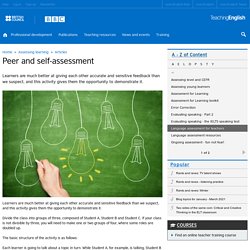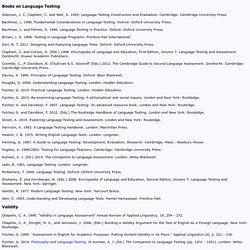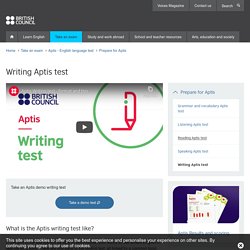

7 Tips For Peer And Self-Assessment. Christina Brown Christina is an Art and Design Teacher in a London secondary school.

In her third year of teaching, she has also just completed an MA in Art and Design in Education at The Institute of Education (University College London). Christina is also a practicing artist... Read more about Christina Brown How can you ensure pupil-led assessment is meaningful? If used meaningfully and well-managed, peer and self-assessment can improve students’ understanding of a topic, enable them to support one another and have a huge impact on progress. These tips will help to make peer and self-assessment work for both you and your students. 1. Make sure that you are crystal clear what makes a piece of work successful. 2.
Rather than just providing an assessment criteria, have the class get involved with creating it. 3. This can be particularly helpful for assessing creative work, when students can be self-conscious about sharing personal work with the class. Image: Shutterstock. Peer and self-assessment. Learners are much better at giving each other accurate and sensitive feedback than we suspect, and this activity gives them the opportunity to demonstrate it.

Divide the class into groups of three, composed of Student A, Student B and Student C. If your class is not divisible by three, you will need to make one or two groups of four, where some roles are doubled up. The basic structure of the activity is as follows: Each learner is going to talk about a topic in turn. While Student A, for example, is talking, Student B will be listening attentively and encouragingly, and Student C will be taking notes in order to give constructive feedback. Set a time limit – two minutes is enough for most levels although you may want to reduce it to one minute for students at CEFR level A1 and one or one and a half minutes for students at CEFR level A2. After the first round, the learners change roles so that Student B speaks, Student C listens and Student A takes notes.
AWL highlighter. The highlighted text will appear here.

Sorted word list (by sublist) will appear below. Wordlists Sorted by sublist Gapfill maker Choose your flavour Create a gapfill for the above text. Choose from these different types: a simple gap fill, with blanks only (you will need the words above to complete it)a head word gapfill, in which each of the academic words will be replaced by the head word (or by another word form if the replaced word is itself a headword)a word family gapfill, in which each of the academic words will be replaced by another word from the same word family Gapfill will appear here. Like the website? Compleat Lexical Tutor.
English Profile - EGP Online. Aptis - English language test. [bnc] British National Corpus. Dialangweb.lancaster.ac. Five essential listening skills for English learners. How can learners improve their listening comprehension? Teacher Raphael Ahmed shares some useful strategies in one of our top five articles of all time, illustrated by artist Jamie Johnson.
Why listening is important It should not be difficult to realise the importance of listening when we consider that it occupies about 45 per cent of the time adults spend in communication. This is significantly more than speaking, which accounts for 30 per cent, and reading and writing, which make up 16 per cent and nine per cent respectively. Yet, for all its importance, students (and even teachers) often fail to give listening the attention it needs. Text Analyzer - Find the CEFR level of texts from RoadtoGrammar.com. Copy and paste a block of text into the box below and click SUBMIT to analyze it. longer vocabulary list What does the Text Analyzer do?

The Text Analyzer can rate the difficulty level of a text according to the Common European Framework, or CEFR Levels. ESL teachers may wish to use this tool to: determine the approximate level of proficiency that the text is suitable for generate a suggested vocabulary list compare the difficulty levels of two texts get meanings for the suggested vocabulary list (via ninjawords.com) How to use the Text Analyzer Simply copy and paste your text in the box above and click SUBMIT. How does the Text Analyzer work? Each word in the submitted text is compared to a list of the 10,000 most commonly used words in English. You can expect slightly different results compared to the Flesch-Kincaid Index. What is word complexity? This is the average position of the words in the list of 10,000 most frequent words in English.
School of Linguistics and Applied Language Studies. Text Inspector. CEFTrain Project. Bank of supplementary descriptors. This page contains links to a variety of documents presenting CEFR-related descriptors that have been produced for other purposes such as European Language Portfolios' models (ELP).

Suggested Reading. Books on Language Testing Alderson, J.

C. Clapham, C. and Wall, D. 1995. Language Testing Construction and Evaluation. Cambridge: Cambridge University Press. Writing Aptis test. What is the Aptis writing test like?

In this part of the test you will be able to demonstrate your ability to use written English in real-life situations. There are four parts to the Writing test, all linked by a common topic. International language standards. CEFR and Language Assessment.